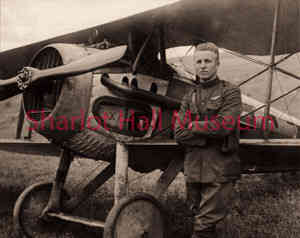By Keith Warren Lloyd
On Sunday, September 29, 1918, twenty-one-year-old Second Lieutenant Frank Luke Jr. from Phoenix, Arizona, took off from a tiny airstrip just outside the ruined city of Verdun, France. Flying in the open cockpit of a camouflaged Spad XIII, a 235-horsepower French-built biplane with American markings and armed with a pair of Vickers machine guns, the tall, blond pilot had to bank sharply to avoid the enemy gunners lying in wait just over the crest of a nearby ridge.
Before the day was over, Frank Luke would accomplish incredible feats that would firmly establish his place in aviation history, and for which he would receive the Congressional Medal of Honor. But he would not return from the mission.
 In 1897, Phoenix was a small farming community of 5500 when Frank Luke was born to a family of nine children. He quickly developed a restless spirit, lettering in several sports at Phoenix Union High School and becoming an avid outdoorsman. When America entered the First World War in April 1917, Luke volunteered for pilot training with the newly formed Aviation Section of the US Army Signal Corps. After earning his aviator’s wings at Rockwell Field on Coronado Island in San Diego, Luke was posted to the 27th Aero Squadron in France on the Western Front.
In 1897, Phoenix was a small farming community of 5500 when Frank Luke was born to a family of nine children. He quickly developed a restless spirit, lettering in several sports at Phoenix Union High School and becoming an avid outdoorsman. When America entered the First World War in April 1917, Luke volunteered for pilot training with the newly formed Aviation Section of the US Army Signal Corps. After earning his aviator’s wings at Rockwell Field on Coronado Island in San Diego, Luke was posted to the 27th Aero Squadron in France on the Western Front.
Described as a “high-strung, excitable boy” by one of his peers, Luke’s overbearing self-confidence and swaggering cowboy demeanor soon raised the ire of his Ivy League educated squadron mates. On one of his first patrols over the Western Front, Luke claimed to have shot down an enemy aircraft, but no one witnessed it. He was quickly labelled a “four-flusher” — a liar. He found a friend in Lieutenant Joseph Wehner, a young pilot who was also under suspicion because of his ties to Germany. Together they would make history.
German observation balloons, or drachens, were hydrogen-filled blimps tethered to the ground by two-thousand-foot steel cables and equipped with a gondola for a trained observer. The balloons made excellent artillery spotting platforms over the trenches of the Western Front and were considered highly valued military assets. Because of this, they were ringed with anti-aircraft guns and protected by German fighter planes.
Most American fighter pilots considered attacking a balloon a suicide mission, but this did not discourage Luke. In just four days, with his trusted friend Joe Wehner flying his wing, Luke destroyed eight of them. On September 18, 1918, the day Luke shot down two balloons and three German airplanes to take the lead in becoming America’s Ace of Aces, Joe Wehner was killed in action.
 On September 29, 1918, Luke took off alone from Verdun. After destroying three German observation balloons and strafing German troops, he landed his damaged Spad behind enemy lines near the village of Murvaux. He had been wounded and was quickly surrounded. German infantrymen called on him to surrender. In response, Luke drew his service pistol and fired until he was killed.
On September 29, 1918, Luke took off alone from Verdun. After destroying three German observation balloons and strafing German troops, he landed his damaged Spad behind enemy lines near the village of Murvaux. He had been wounded and was quickly surrounded. German infantrymen called on him to surrender. In response, Luke drew his service pistol and fired until he was killed.
For his actions that day, Frank Luke Jr. became the first aviator to receive the Medal of Honor. Luke Air Force Base, 20 miles west of his native Phoenix, was named in his honor and is today the largest fighter pilot training facility in the world.
Join us Saturday, March 16th at 2 p.m. for a free lecture by Keith Warren Lloyd in the West Gallery of Sharlot Hall Museum’s Lawler Exhibit Center. The lecture highlights Frank Luke, a WW I Congressional Medal of Honor recipient, for whom Luke Air Force base west of Phoenix is named.
“Days Past” is a collaborative project of the Sharlot Hall Museum and the Prescott Corral of Westerners International (www.prescottcorral.org). This and other Days Past articles are also available at https://sharlothallmuseum.org/articles/days-past-articles.l. The public is encouraged to submit proposed articles and inquiries to dayspast@sharlothallmuseum.org. Please contact SHM Library & Archives reference desk at 928-445-3122 Ext. 2, or via email at archivesrequest@sharlothallmuseum.org for information or assistance with photo requests.


